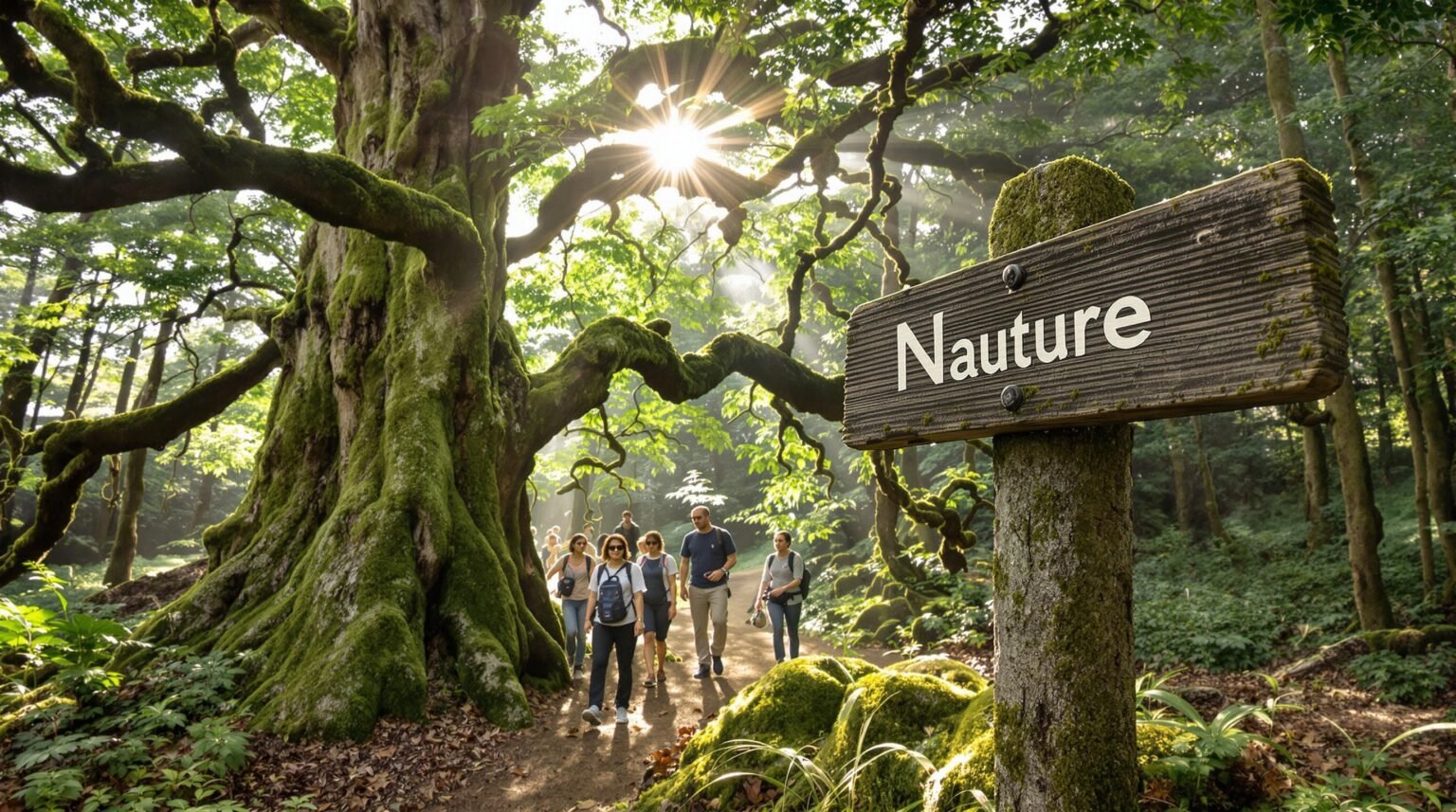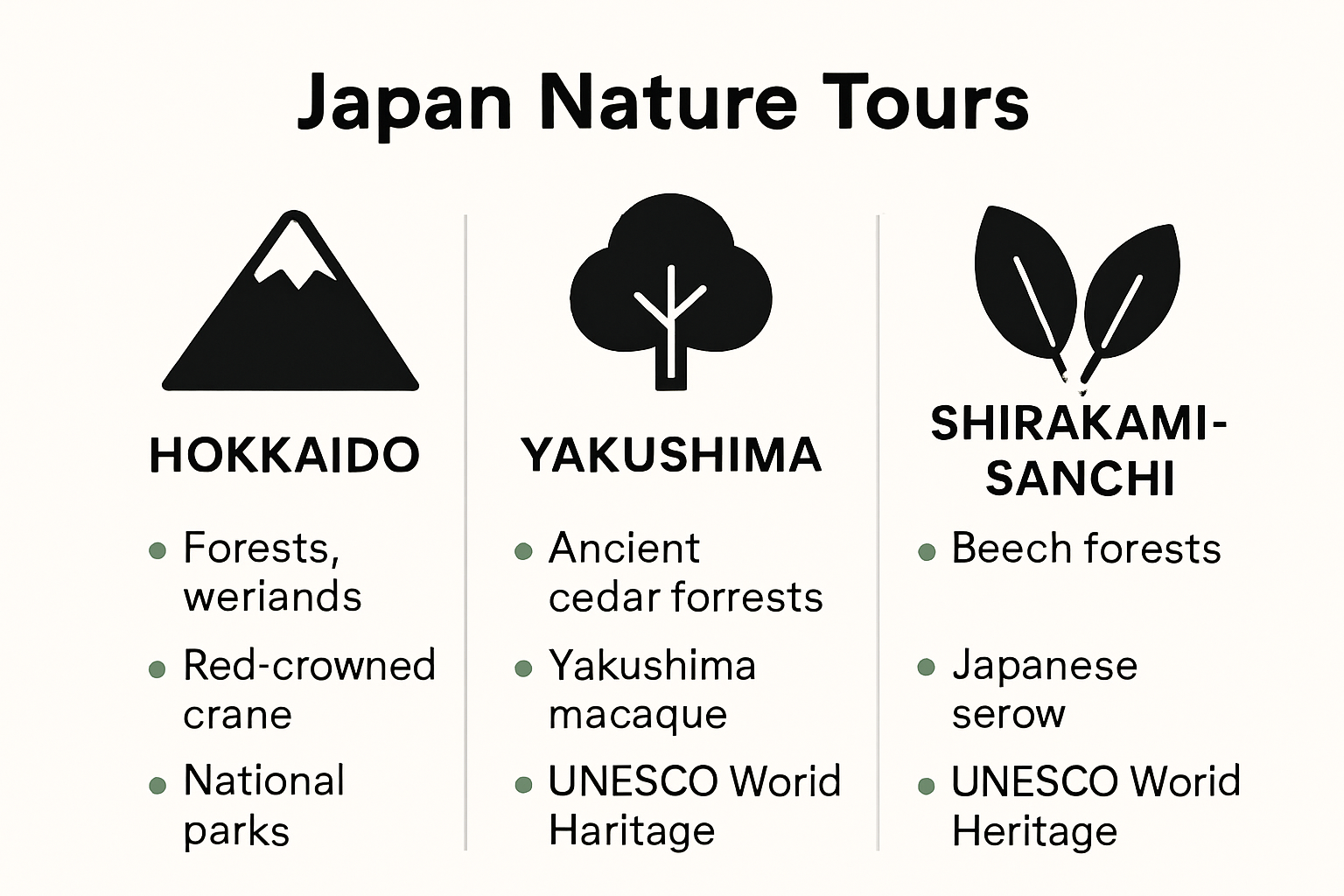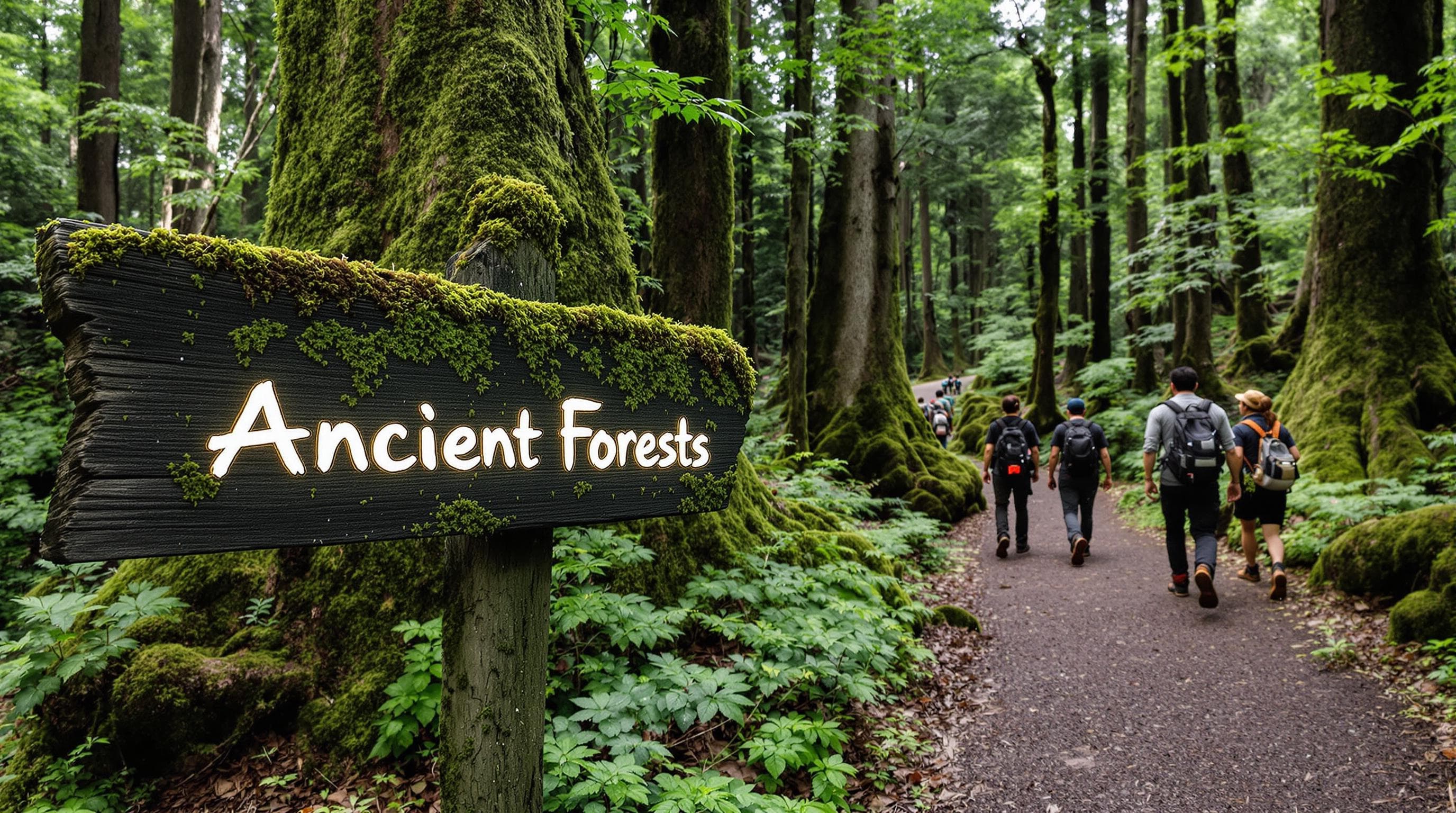
Japan is home to some of the world’s most diverse and breathtaking wilderness, drawing ecotourists from every continent. Yet, here’s something few realize. Yakushima Island shelters cedar trees that are up to 7,000 years old, older than the Roman Empire. Most nature trips just scratch the surface, but in Japan, these tours dive deep, connecting travelers with living history and protecting ecosystems at the same time.
| Takeaway | Explanation |
|---|---|
| Diverse Natural Destinations | Japan’s ecotourism offerings include pristine areas like Hokkaido, Yakushima Island, and Shirakami-Sanchi, each showcasing significant biodiversity and conservation efforts. |
| Wildlife and Conservation Focus | Visitors can engage in immersive wildlife experiences that prioritize conservation, such as guided tours in biodiverse hotspots like the Aya Biosphere Reserve and Yanbaru’s unique habitats. |
| Strategic Tour Planning | Effective nature tours require attention to seasonal patterns, local regulations, and responsible travel practices to minimize environmental impact and ensure sustainable experiences. |
| Training and Certification for Operators | Travel agencies should pursue sustainable certifications and professional training to effectively integrate local knowledge and community participation into ecotourism efforts. |
| Embracing Technology | Utilizing technological innovations, such as digital education and carbon tracking, can enhance ecotourism while reducing ecological footprints and improving traveler engagement. |

Japan offers extraordinary landscapes that beckon nature enthusiasts and ecotourists seeking immersive wilderness experiences. From subtropical islands to ancient forests, the country presents a diverse array of natural environments that showcase remarkable biodiversity and conservation efforts.
The northernmost island of Japan, Hokkaido, represents a pinnacle of natural beauty and ecological preservation. Explore our curated nature destinations for travelers seeking unspoiled environments. The Shiretoko Peninsula, recognized as a UNESCO World Heritage Site, stands as a testament to Japan’s commitment to ecological conservation. This extraordinary region hosts one of the world’s most significant brown bear populations and offers unique wildlife viewing opportunities.
Travelers can engage in responsible ecotourism activities such as guided bear watching, where licensed professionals ensure minimal environmental disruption. The peninsula’s ecosystem supports diverse marine and terrestrial wildlife, making it a critical habitat for numerous species. Winter visitors can experience remarkable phenomena like ice drift walking, providing an intimate connection with Hokkaido’s rugged natural landscape.
Beyond Hokkaido, Japan’s southern regions offer equally compelling natural destinations. Yakushima Island, located off the southern coast, presents a remarkable subtropical ecosystem featuring ancient cedar forests that have stood for over a millennium. Designated as a UNESCO World Heritage Site in 1993, this island offers travelers an extraordinary opportunity to walk among trees older than many civilizations.
The island’s dense forests are home to unique flora and fauna, with hiking trails that wind through mystical landscapes reminiscent of primeval woodlands. Visitors can explore the famous Jomon Sugi, an ancient cedar tree estimated to be between 2,000 and 7,000 years old, representing a living connection to Japan’s natural history. Alongside forest exploration, Yakushima provides access to pristine subtropical beaches, creating a diverse ecosystem that attracts botanists, photographers, and nature enthusiasts.

In the heart of Japan, Shirakami-Sanchi represents another critical ecological treasure. Spanning Aomori and Akita Prefectures, this mountainous region contains one of East Asia’s largest remaining virgin beech forests. As the first natural site in Japan to receive UNESCO World Heritage status, Shirakami-Sanchi offers sustainable hiking experiences through untouched wilderness.
The area supports remarkable biodiversity, including rare wildlife species such as the Japanese black bear and golden eagle. Hikers and nature photographers can explore cascading waterfalls, dense beech forests, and pristine mountain landscapes that remain largely unchanged for centuries. Conservation efforts in this region demonstrate Japan’s commitment to preserving its natural heritage while offering controlled, responsible tourism experiences.
These destinations represent more than scenic locations they are living ecosystems that require respectful, sustainable interaction. Travelers interested in japan nature tours in 2025 will find these sites offer not just visual splendor but profound connections to natural environments that have been carefully preserved through generations of careful stewardship.
To help readers compare Japan’s top ecotourism destinations, the following table summarizes key features of each location discussed in this section:
| Destination | Location/Region | Key Features | UNESCO World Heritage | Notable Wildlife |
|---|---|---|---|---|
| Shiretoko Peninsula | Hokkaido (north) | Pristine wilderness, ice drift, guided bear watching | Yes | Brown bears, marine/terrestrial fauna |
| Yakushima Island | Kagoshima Prefecture (south) | Ancient cedar forests, subtropical beaches, Jomon Sugi | Yes | Ryukyu flying fox, unique flora |
| Shirakami-Sanchi | Aomori/Akita (central) | Virgin beech forests, waterfalls, mountain landscapes | Yes | Japanese black bear, golden eagle |
Japan offers remarkable wildlife encounters that go beyond traditional tourism, providing immersive experiences that prioritize conservation, education, and sustainable interaction with unique ecosystems. These experiences not only allow travelers to witness extraordinary wildlife but also contribute to environmental preservation efforts.
The Aya Biosphere Reserve in Kyushu represents a prime example of Japan’s commitment to wildlife preservation. According to ecological research, this reserve encompasses an extraordinary ecosystem supporting 1,033 botanical species, 145 fungal species, 70 avian species, and 19 mammal species. Explore our detailed nature experiences to understand the intricate balance of these natural environments.
Visitors can observe rare wildlife like the Japanese serow and golden eagles in their natural habitats. Professional guides ensure minimal ecological disruption while providing educational insights into the complex interactions within these ecosystems. The reserve demonstrates how carefully managed wildlife tourism can simultaneously support conservation goals and provide transformative visitor experiences.
Okinawa’s Yanbaru region presents another compelling wildlife tourism destination. Research on wildlife tourism emphasizes the critical role of community involvement in developing sustainable wildlife experiences. The area is home to the endangered Okinawa rail, a bird species found nowhere else in the world, making it a crucial site for conservation and scientific study.
Guided tours in Yanbaru focus on responsible observation, allowing travelers to witness unique wildlife while supporting local conservation initiatives. These experiences are designed to create awareness about the fragile ecosystems and the importance of protecting endemic species. Visitors learn about the delicate balance between human interaction and wildlife preservation, gaining a deeper understanding of Japan’s biodiversity.
Yakushima National Park, a UNESCO World Heritage site, offers an extraordinary blend of marine and terrestrial wildlife experiences. The park hosts an impressive biodiversity, including over 1,900 plant species, 16 mammal species, and 150 bird species. The endangered Ryukyu flying fox represents just one of the remarkable species that call this ecosystem home.
Ecotourists can engage in carefully structured wildlife viewing experiences that prioritize animal welfare and habitat preservation. Kayaking, guided forest walks, and specialized photography tours provide opportunities to observe wildlife in their natural settings. These experiences are designed not just for observation but for creating meaningful connections between travelers and the natural world.
These wildlife and ecotourism experiences in Japan represent more than simple recreational activities. They are educational journeys that highlight the intricate relationships between humans, wildlife, and ecosystems. By participating in these tours, travelers become active contributors to conservation efforts, supporting local communities and helping protect some of the world’s most unique and endangered species.
Below is a table summarizing selected Japanese wildlife hotspots and their ecological highlights to make key facts easily scannable for readers:
| Destination/Region | Notable Species/Features | Ecotourism Focus |
|---|---|---|
| Aya Biosphere Reserve | 1,033 plant species, 70 birds, Japanese serow, golden eagle | Guided tours, scientific research |
| Okinawa (Yanbaru) | Endangered Okinawa rail, endemic species | Responsible observation, community involvement |
| Yakushima National Park | 1,900 plant species, 16 mammals, 150 bird species, Ryukyu flying fox | Guided hikes, birdwatching, kayaking |
Planning a successful nature tour in Japan requires careful consideration of ecological sustainability, cultural sensitivity, and strategic preparation. Travelers seeking immersive natural experiences must navigate complex environmental and regulatory landscapes to ensure responsible and meaningful exploration.
The Japanese government has established robust guidelines for sustainable tourism through the Ecotourism Promotion Act, which aims to balance conservation efforts with tourism development. Explore our comprehensive destination planning resources to understand the intricate regulations governing nature tours. The act emphasizes preserving natural environments while supporting local economies, creating a holistic approach to ecological tourism.
Travelers must work with certified organizations that understand these regulations. The Japan Ecotourism Society plays a crucial role in educating industry professionals and promoting businesses that prioritize natural, cultural, and historical heritage preservation. This framework ensures that nature tours contribute positively to environmental conservation and local community development.
Successful nature tours in Japan demand meticulous planning that considers seasonal variations and ecological sensitivities. The Ministry of the Environment has developed specialized plans for regions like Amami-Oshima and Iriomote Island, demonstrating the need for region-specific approaches to ecotourism.
Key planning considerations include:
Preparing for a nature tour requires more than standard travel planning. Travelers must develop a deep understanding of ecological principles and cultural respect. This involves:
Successful Japan nature tours in 2025 will prioritize immersive experiences that connect travelers deeply with natural environments while maintaining strict ecological standards. By approaching nature tours with respect, preparation, and a commitment to sustainability, travelers can create transformative experiences that benefit both the environment and local communities.
The future of nature tourism in Japan depends on a delicate balance between exploration and preservation. Travelers who approach their journeys with mindfulness and respect will not only enjoy extraordinary natural experiences but also contribute to the ongoing conservation of Japan’s remarkable ecological landscapes.
Travel agencies and operators play a critical role in shaping sustainable nature tourism experiences in Japan. As the ecotourism landscape evolves, professionals must adapt their strategies to meet increasingly sophisticated environmental and cultural preservation standards.
The Global Sustainable Tourism Council (GSTC) has been instrumental in providing specialized training for Japanese tourism professionals. According to their research, implementing context-specific sustainability standards is crucial for effective ecotourism management. Learn more about our sustainable tour practices to understand the intricate balance between tourism and conservation.
Travel agencies should prioritize professional certifications that demonstrate commitment to sustainable practices. The Japan Ecotourism Society offers comprehensive training programs that help operators develop skills in environmental conservation, local community engagement, and responsible tourism management. These certifications not only enhance credibility but also provide practical frameworks for creating meaningful ecological experiences.
The Japan Tourism Agency emphasizes the importance of integrating local knowledge and community perspectives into tour design. Successful nature tours require deep collaboration with local communities, indigenous experts, and conservation professionals.
Key strategies for effective tour design include:
Modern travel agencies must leverage technology to enhance sustainable tourism experiences. Advanced tracking systems, digital educational resources, and virtual pre-tour orientation can help minimize environmental impact while providing richer, more informed travel experiences.
Innovative approaches should focus on:
Successful nature tourism in Japan requires a holistic approach that balances traveler experiences, environmental preservation, and local community well-being. Travel agencies and operators who embrace these principles will not only create memorable experiences but also contribute to long-term ecological and cultural sustainability.
As the ecotourism landscape continues to evolve, agencies must remain adaptable, innovative, and deeply committed to the principles of responsible travel. By prioritizing education, collaboration, and technological innovation, travel professionals can help shape a more sustainable future for nature tourism in Japan.
Japan’s top ecotourism destinations for 2025 include Hokkaido for its pristine wilderness, Yakushima Island for its ancient cedar forests, and Shirakami-Sanchi for its virgin beech forests. Each offers unique biodiversity and immersive natural experiences.
Travelers can engage in wildlife experiences like guided bear watching in Hokkaido or exploring the Aya Biosphere Reserve, where you can see rare species such as the Japanese serow and golden eagles in their natural habitats.
When planning a nature tour in Japan, consider seasonal wildlife patterns, local regulations for conservation, and ecological sensitivities. It’s essential to choose guided tours with certified ecological guides to promote responsible travel.
Travel agencies can ensure sustainable practices by obtaining certifications from organizations like the Japan Ecotourism Society, collaborating with local communities, and emphasizing environmental education and minimal impact tour design.
You have just explored Japan’s most stunning wilderness destinations for 2025, from Hokkaido’s unspoiled landscapes to Yakushima’s ancient cedar forests. But many travelers worry about missing genuine ecotourism experiences, struggling with seasonal planning, or finding guided tours that truly protect rare wildlife and fragile ecosystems. Authentic connection can feel out of reach without the right expertise and support.

japan nature tours
Why settle for generic tours when you can have a custom itinerary shaped by nature-loving experts? Unlock immersive, eco-friendly adventures created just for you with Japan Ichiban Tours. Work directly with local guides who know Japan’s unique habitats and conservation challenges. Discover our full range of experiences and get inspired for your next journey by browsing our latest destination ideas. Your dream ecotourism trip awaits—start planning your 2025 nature tour with trusted local specialists today.

Discover Japan Like Never Before 🇯🇵








Copyright © 2025 Japan Ichiban Tours | made with ❤️ by ideavire.com
Please select a template first

0 Comments